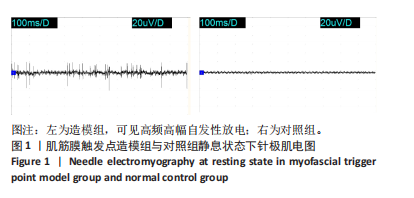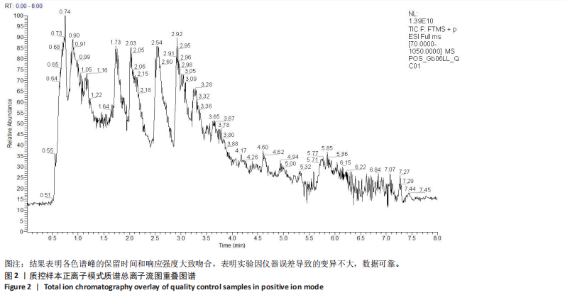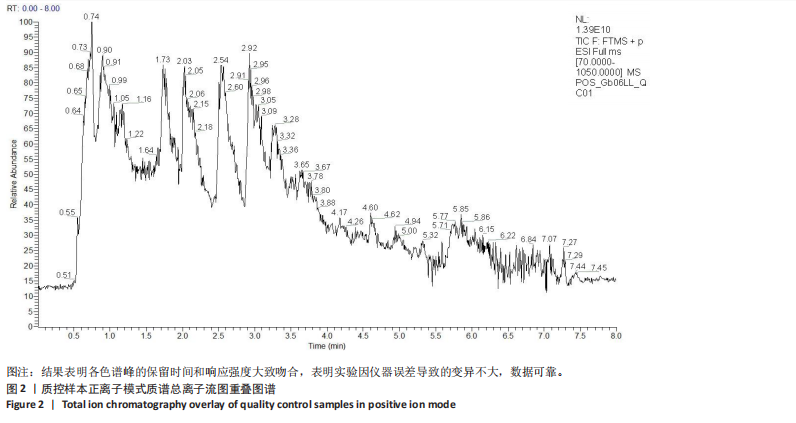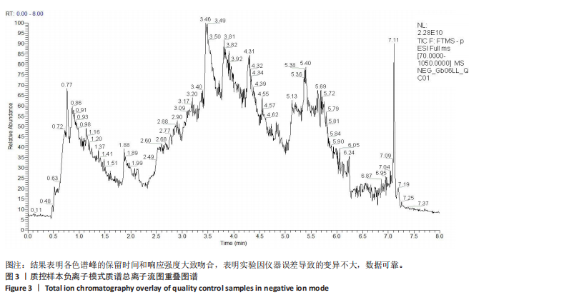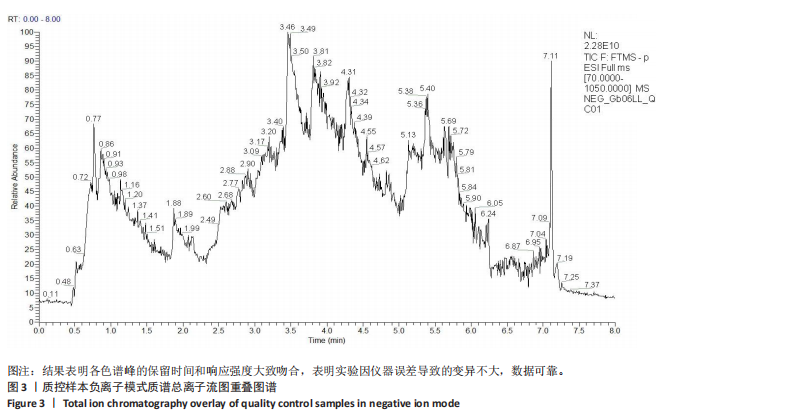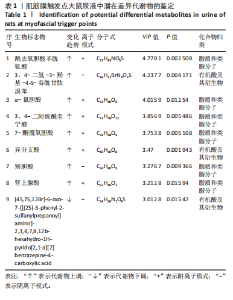Chinese Journal of Tissue Engineering Research ›› 2025, Vol. 29 ›› Issue (8): 1585-1592.doi: 10.12307/2025.351
Previous Articles Next Articles
Metabolomic analysis of urine in a rat model of chronic myofascial trigger points
Liu Lin, Liu Shixuan, Lu Xinyue, Wang Kan
- School of Sport and Health, Nanjing Sport Institute, Nanjing 210014, Jiangsu Province, China
-
Received:2024-03-20Accepted:2024-05-09Online:2025-03-18Published:2024-07-05 -
Contact:Wang Kan, MD, Lecturer, School of Sport and Health, Nanjing Sport Institute, Nanjing 210014, Jiangsu Province, China -
About author:School of Sport and Health, Nanjing Sport Institute, Nanjing 210014, Jiangsu Province, China Liu Lin, MD, Lecturer, School of Sport and Health, Nanjing Sport Institute, Nanjing 210014, Jiangsu Province, China -
Supported by:the National Natural Science Foundation of China, No. 32000829 (to LL); Jiangsu Province University “Blue Engineering” Project (to LL)
CLC Number:
Cite this article
Liu Lin, Liu Shixuan, Lu Xinyue, Wang Kan. Metabolomic analysis of urine in a rat model of chronic myofascial trigger points [J]. Chinese Journal of Tissue Engineering Research, 2025, 29(8): 1585-1592.
share this article
Add to citation manager EndNote|Reference Manager|ProCite|BibTeX|RefWorks

的影响比较有限(图4A,B),但肌筋膜触发点造模干预组大鼠尿液代谢物与正常对照组大鼠尿液代谢物比较的正交偏最小二乘判别分析图的分离趋势明显(图4C,D)。 2.5 潜在生物标志物的筛选 根据正交偏最小二乘法判别分析模型得到的变量权重值 (variable importance in projection,VIP) 结合t检验以及差异倍数 (FC) 分析,此次实验以 VIP > 1.5 且 P < 0.01 为标准,筛选差异代谢物。其中,FC > 1.2 且 P < 0.01 的物质为该比较组所有上调差异代谢物,FC < 0.8且 P < 0.01 的物质为该比较组所有下调差异代谢物。正常组与造模组筛选差异代谢标志物数共32个,其中上调21个、下调11个,见图5和表1。表1列举了VIP > 3 的非常显著性差异代谢物。 2.6 代谢通路分析 将已鉴定的代谢物导入在线数据库MetaboAnalyst 4.0及KEGG数据库进行代谢通路富集分析。研究表明,肌筋膜触发点造模对机体初级胆汁酸生物合成、花生四烯酸代谢2条通路产生显著性影响(P < 0.05),见图6和表2。经过KEGG通路的差异种属分析表明,两条代谢通路均属于新陈代谢种属,见表2。"

| [1] LIU L, WU ZH, HUANG QM, et al. Clinical observations in treatment of lower extremity varicose veins with trigger points acupuncture. Phlebology. 2023;38(10):675-682. [2] ZHUANG X, TAN S, HUANG Q. Understanding of myofascial trigger points. Chin Med J (Engl). 2014;127(24):4271-4277. [3] SUN WQ, PAN DB, HUANG QM. Successful treatment of persistent hiccups with myofascial trigger point dry needling: a case report. Acupunct Med. 2021;39(1):72-74. [4] TANG L, LIU SS, GAO F, et al. Use of dry needling therapy to improve lower limb dysfunction in a patient with 10-year cerebral hemorrhage sequelae: a case report. Acupunct Med. 2022;40(3):270-271. [5] HUANG QM, LIU L. Wet needling of myofascial trigger points in abdominal muscles for treatment of primary dysmenorrhoea. Acupunct Med. 2014; 32(4):346-349. [6] 刘首芳, 马彦韬, 张艳茹, 等. 针刺肌筋膜激痛点治疗带状疱疹后神经痛[J]. 中国疼痛医学杂志,2022,28(8):633-636. [7] 黄强民, 蒋佳, 郭少卿, 等. 肌筋膜触发点诊疗技术实训教程[M]. 北京: 科学技术文献出版社,2022. [8] HUANG QM, XU AL, JI LJ, et al. Understanding of myofascial trigger points (2): acupuncture vs dry needling. Phys Med Rehabil Int. 2018; 5(3):1146. [9] 黄强民, 张亚丹, 马彦韬, 等. 肌筋膜触发点的理解:针灸与干针之争和现代针理学[J]. 中国针灸,2018,38(7):779-784. [10] HUANG QM, ZHANG H. How to understand MTrPs induced human impairments and dysfunctions. Biomed J Sci Tech Res. 2019;16(2): 2812. [11] 李鳌, 孙宏伟, 崔彦. 代谢组学应用与研究进展[J]. 医学研究杂志, 2020,49(1):168-171. [12] 刘慧敏, 张悦, 王佳艺, 等. 代谢组学前沿技术进展及在中药现代研究中的应用[J].中草药,2024,55(3):969-977. [13] 王新华,杨延昕,王鹦君,等.多组学多维度的检测用于淋巴瘤患者的疗效监测[J].中国实验血液学杂志,2023,31(3):746-752. [14] 夏雨, 丁海丽, 张瑞驰, 等. 基于代谢组学技术分析一次大负荷运动后骨骼肌代谢时序性变化[C]. 2023年中国生理学会运动生理学专业委员会学术会议暨运动生理学专业委员会成立20周年庆祝大会, 南京: 2023. [15] HADREVI J, GHAFOURI B, SJORS A, et al. Comparative metabolomics of muscle interstitium fluid in human trapezius myalgia: an in vivo microdialysis study. Eur J Appl Physiol. 2013;113(12):2977-2989.
[16] HADREVI J. New aspects on chronic trapezius myalgia: contribution of metabolomics and proteomics. J Musculoskelet Pain. 2014;22(4): 382-388. [17] 刘琳, 刘庆广, 黄强民. 创伤性肌筋膜触发点的形成对大鼠骨骼肌肌梭内NT-3及受体TrkC的表达影响[J]. 南京体育学院学报,2023, 22(7):44-49. [18] HUANG QM, YE G, ZHAO ZY, et al. Myoelectrical activity and muscle morphology in a rat model of myofascial trigger points induced by blunt trauma to the vastus mediali. Acupunct Med. 2013;31(1):65-73. [19] LI L, HUANG Q, BARBERO M, et al. Proteins and signaling pathways response to dry needling combined withstatic stretching treatment for chronic myofascial pain in a rat model: an explorative proteomic study. Int J Mol Sci. 2019;20(3):564. [20] 李丽辉. 肌筋膜触发点的蛋白组学研究及针刺和静态拉伸治疗后的改变[D]. 上海:上海体育学院,2019. [21] 靳飞鸿. 肌筋膜扳机点的转录组学分析以及EphB在扳机点的表达和机制研究[D]. 济南:山东大学,2021. [22] 张灵雁, 于东升, 李晓萍. 基于“肠道菌群–胆汁酸代谢”探讨茵栀黄颗粒对胆汁淤积症小鼠的改善作用及其机制[J]. 现代药物与临床,2023,38(11):2660-2671. [23] 唐一. 围产期高盐饮食对子代小鼠胆汁酸代谢的影响[D]. 武汉:华中科技大学,2020. [24] 贺晓立, 王毅兴, 王晓柠, 等. 慢性乙型肝炎患者肝肾阴虚证和湿热蕴结证血清胆汁酸谱变化[J]. 中国中西医结合杂志,2020,40(5): 528-534. [25] 靳蕊, 李磊. 胆汁酸及其受体在溃疡性结肠炎中的作用及中药对其干预的研究进展[J]. 中国中西医结合消化杂志,2023,31(12):951-954. [26] MINERBI A, GONZALEZ E, BRERETON N, et al. Altered serum bile acid profile in fibromyalgia is associated with specific gut microbiome changes and symptom severity. Pain. 2023;164(2):e66-e76. [27] JIA W, XIE G, JIA W. Bile acid-microbiota crosstalk in gastrointestinal inflammation and carcinogenesis. Nat Rev Gastroenterol Hepatol. 2018;15(2):111-128. [28] TICHO AL, MALHOTRA P, DUDEJA PK, et al. Bile acid receptors and gastrointestinal functions. Liver Res. 2019;3(1):31-39. [29] LI WT, LUO QQ, WANG B, et al. Bile acids induce visceral hypersensitivity via mucosal mast cell-to-nociceptor signaling that involves the farnesoid X receptor/nerve growth factor/transient receptor potential vanilloid 1 axis. FASEB J. 2019;33(2):2435-2450. [30] LIEU T, JAYAWEERA G, ZHAO P, et al. The bile acid receptor TGR5 activates the TRPA1 channel to induce itch in mice. Gastroenterology. 2014;147(6):1417-1428. [31] ALEMI F, KWON E, POOLE DP, et al. The TGR5 receptor mediates bile acid-induced itch and analgesia. J Clin Invest. 2013;123(4):1513-1530. [32] DAWSON PA, KARPEN SJ. Bile acids reach out to the spinal cord: New insights to the pathogenesis of itch and analgesia in cholestatic liver disease.Hepatology. 2014;59(4):1638-1641. [33] 王标, 唐流刚, 吴晓惠, 等. 疏风止痛饮联合颈四针治疗神经根型颈椎病疗效及对白三烯、炎症因子影响[J]. 海南医学院学报, 2021,27(4):275-279. [34] FIELD JJ, STRUNK RC, KNIGHT-PERRY JE, et al. Urinary cysteinyl leukotriene E4 significantly increases during pain in children and adults with sickle cell disease. Am J Hematol. 2009;84(4):231-233. [35] JENNINGS JE, RAMKUMAR T, MAO J, et al. Elevated urinary leukotriene E4 levels are associated with hospitalization for pain in children with sickle cell disease. Am J Hematol. 2008;83(8):640-643. [36] 郭振新. 补充扇贝寡肽对运动大鼠骨骼肌废用性萎缩的干预研究[J]. 广州体育学院学报,2013,33(3):87-93. [37] 王霞, 蒋礼, 何燕玲, 等. 黑骨藤中咖啡酰基奎宁酸类化合物体外抗类风湿性关节炎机制研究[J]. 中国药理学通报,2018,34(10):1362-1367. [38] 王霞, 杨健, 宋菲, 等. 苗药黑骨藤中咖啡酰基奎宁酸类部位对人类风湿性关节炎成纤维样滑膜细胞MH7A增殖及炎症因子分泌的影响[J]. 中国药房,2017,28(28):3949-3952. |
| [1] | Miao Jiahang, Ma Sheng, Li Qupeng, Yu Huilin, Hu Tianyu, Gao Xiao, Feng Hu. Cervical lordosis ratio can be used as a decision-making indicator for selection of posterior surgical approach for multi-level cervical spondylotic myelopathy [J]. Chinese Journal of Tissue Engineering Research, 2025, 29(9): 1796-1802. |
| [2] | Yu Shuai, Liu Jiawei, Zhu Bin, Pan Tan, Li Xinglong, Sun Guangfeng, Yu Haiyang, Ding Ya, Wang Hongliang. Hot issues and application prospects of small molecule drugs in treatment of osteoarthritis [J]. Chinese Journal of Tissue Engineering Research, 2025, 29(9): 1913-1922. |
| [3] | Deng Keqi, Li Guangdi, Goswami Ashutosh, Liu Xingyu, He Xiaoyong. Screening and validation of Hub genes for iron overload in osteoarthritis based on bioinformatics [J]. Chinese Journal of Tissue Engineering Research, 2025, 29(9): 1972-1980. |
| [4] | Su Xiaoyang, Chen Wenting, Fu Yidan, Zhao Yan, Lan Danfeng, Yang Qiuping. Correlation between Mer receptor tyrosine kinase and diabetic peripheral neuropathy in Sprague-Dawley rats [J]. Chinese Journal of Tissue Engineering Research, 2025, 29(8): 1593-1599. |
| [5] | Li Jun, Gong Jingjing, Sun Guobin, Guo Rui, Ding Yang, Qiang Lijuan, Zhang Xiaoli, Fang Zhanhai . miR-27a-3p promotes the proliferation of human hypertrophic scar fibroblasts by regulating mitogen-activated protein kinase signaling pathway [J]. Chinese Journal of Tissue Engineering Research, 2025, 29(8): 1609-1617. |
| [6] | Jing Ruyi, Chen Yingxin, Cao Lei . Prognosis of deep lamellar keratoplasty versus penetrating keratoplasty in the treatment of stromal corneal dystrophy [J]. Chinese Journal of Tissue Engineering Research, 2025, 29(8): 1626-1633. |
| [7] | Wang Yida, Liu Jun, Wang Xiaoling, Wang Liyan, Yang Chengru, Zhang Xuexiao. Effects of wearable electronic device-based interventions on physical activity and sedentary behavior in healthy adolescents: a meta-analysis [J]. Chinese Journal of Tissue Engineering Research, 2025, 29(8): 1693-1704. |
| [8] | Zheng Huakun, Yin Mingyue, Liu Qian. Effects of interval and continuous training on the quality of life in physically inactive adults: a meta-analysis [J]. Chinese Journal of Tissue Engineering Research, 2025, 29(8): 1727-1740. |
| [9] | Zhao Jiacheng, Ren Shiqi, Zhu Qin, Liu Jiajia, Zhu Xiang, Yang Yang. Bioinformatics analysis of potential biomarkers for primary osteoporosis [J]. Chinese Journal of Tissue Engineering Research, 2025, 29(8): 1741-1750. |
| [10] | Cai Yaohao, Lang Lyu, Li Hong. Assessing the bone mass of the residual alveolar ridge in the first molar for implant placement by cone-beam computed tomography [J]. Chinese Journal of Tissue Engineering Research, 2025, 29(8): 1572-1577. |
| [11] | Hu Taotao, Liu Bing, Chen Cheng, Yin Zongyin, Kan Daohong, Ni Jie, Ye Lingxiao, Zheng Xiangbing, Yan Min, Zou Yong. Human amniotic mesenchymal stem cells overexpressing neuregulin-1 promote skin wound healing in mice [J]. Chinese Journal of Tissue Engineering Research, 2025, 29(7): 1343-1349. |
| [12] | Jin Kai, Tang Ting, Li Meile, Xie Yuan. Effects of conditioned medium and exosomes of human umbilical cord mesenchymal stem cells on proliferation, migration, invasion, and apoptosis of hepatocellular carcinoma cells [J]. Chinese Journal of Tissue Engineering Research, 2025, 29(7): 1350-1355. |
| [13] | Liu Qi, Li Linzhen, Li Yusheng, Jiao Hongzhuo, Yang Cheng, Zhang Juntao. Icariin-containing serum promotes chondrocyte proliferation and chondrogenic differentiation of stem cells in the co-culture system of three kinds of cells [J]. Chinese Journal of Tissue Engineering Research, 2025, 29(7): 1371-1379. |
| [14] | Huang Ting, Zheng Xiaohan, Zhong Yuanji, Wei Yanzhao, Wei Xufang, Cao Xudong, Feng Xiaoli, Zhao Zhenqiang. Effects of macrophage migration inhibitory factor on survival, proliferation, and differentiation of human embryonic stem cells [J]. Chinese Journal of Tissue Engineering Research, 2025, 29(7): 1380-1387. |
| [15] | He Longcai, Song Wenxue, Ming Jiang, Chen Guangtang, Wang Junhao, Liao Yidong, Cui Junshuan, Xu Kaya. An experimental method for simultaneous extraction and culture of primary cortical neurons and microglial cells from SD rats [J]. Chinese Journal of Tissue Engineering Research, 2025, 29(7): 1395-1400. |
| Viewed | ||||||
|
Full text |
|
|||||
|
Abstract |
|
|||||

